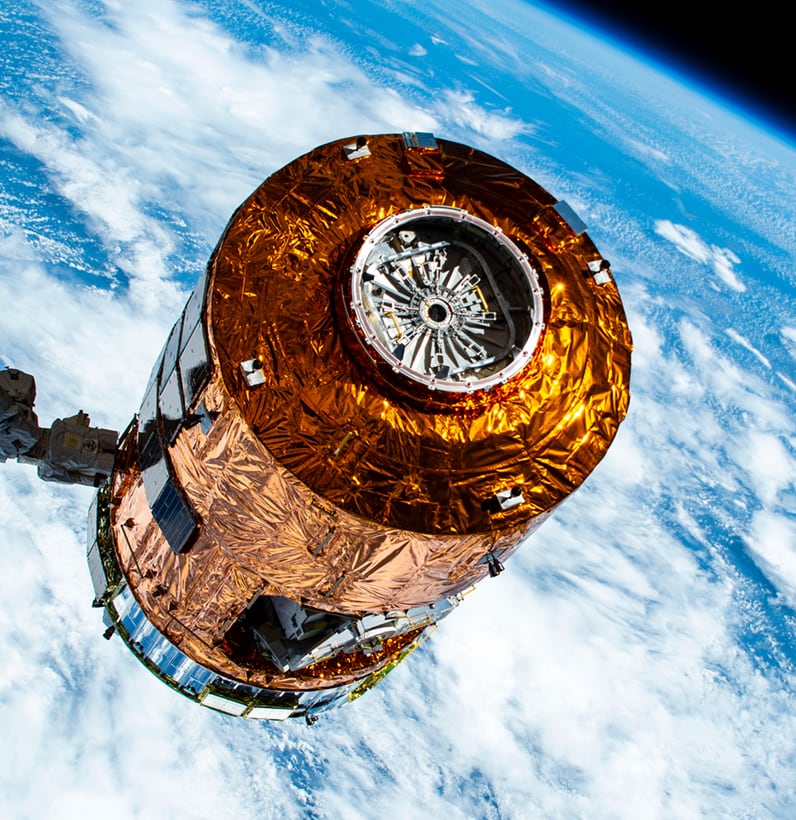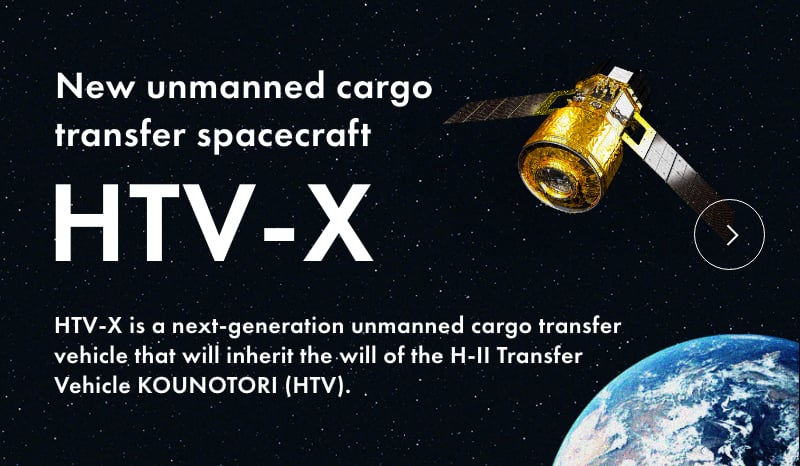The History of KOUNOTORI (HTV)
Nine supply missions successfully completed! Introducing the KOUNOTORI (HTV) that impressed the world with its unique technologies.

The Japanese Space Station Transfer Vehicle that
Opened a New Path to the Future
KOUNOTORI successfully completed nine missions, from the technical demonstration flight of HTV1 in 2009 to the final HTV9 mission of 2020. But what exactly were those missions, and what sorts of results were achieved with KOUNOTORI?
What is KOUNOTORI?

Major contributions to advancing the development of space activities thanks to the largest supply capacity in the world and unique Japanese technologies
The H-II Transfer Vehicle (HTV) KOUNOTORI was an unmanned craft developed in Japan that served as a means for delivering supplies to the ISS.
The KOUNOTORI provided support for the fundamental aspects of ISS operations with unparalleled features such as its ability to carry multiple large pieces of experimental equipment and ISS batteries on a single mission. The original capture-and-berthing technique that Japan developed for KOUNOTORI has since been adopted by private US space vehicles as the standard technique for approaching the ISS.
These and other achievements have earned high regard from NASA and other spaceflight agencies. KOUNOTORI played a major role in boosting Japan's presence in the space field, and its development and operation have led to the acquisition of crucial technologies for the next generation of space development activities.
Related links
KOUNOTORI’s Major Achievements

Established a New Technique for Accessing and Docking with the ISS
The biggest challenge undertaken in KOUNOTORI's development was the adoption of the world-first capture-and-berthing technique as the method for docking with the ISS. This entails the vehicle matching speed with the ISS and traveling alongside it while gradually drawing closer. Once the vehicle is within 10 meters of the station, an astronaut on the ISS uses a robotic arm to capture the vehicle and dock it. Even though this technique is safer than that which was previously used, not even NASA had experimented with it. Accordingly, many people expressed their apprehensions about making it work. However, consolidating Japanese technologies and conducting more than 100 training exercises on the road to launching the technology demonstration vehicle culminated in a flawless launch. Since then, this capture-and-berthing technique has become the standard for approaching and docking with the ISS, used even by such privately developed US supply crafts as the Cygnus and the Dragon.
The Japanese Experiment Module "Kibo" is equipped with a Proximity Communication System (PROX) so the KOUNOTORI can safely draw near to the ISS. Japan developed this new system for the KOUNOTORI to serve as a means for the resupply vehicle and the ISS to communicate directly with one another. This system was also employed by the privately-developed American Cygnus supply vehicle when approaching the ISS. All of the ISS approach operations for Cygnus missions, from the Orb-D1 demonstration flight though mission OA-8, were supported by the HTV Flight Control Team, working from the JAXA Tsukuba Space Center in Japan.

Handling the Critical Mission of Delivering the ISS' Batteries
The KOUNOTORI offered the world's largest spaceflight cargo capacity at around six tons. It was also equipped with an exposed pallet for use in transporting equipment to be used outside the ISS. For these reasons, it excelled in its capacity to efficiently transport large payloads, and as a result, KOUNOTORI were assigned the crucial mission of delivering batteries for the ISS. Missions HTV6 through HTV9 delivered a combined total of 24 large batteries to the ISS, surpassing all expectations. However, it's not enough to simply deliver the batteries. It is necessary to also consider the use of the robot arm and even extravehicular activities while in orbit. In order to be able to change the batteries efficiently, thorough planning went into the initial loading and other aspects of the KOUNOTORI. As a result of repeated discussions with NASA in the search for the optimal approach, the operations in space proceeded even more smoothly than had been expected, placing Japan’s technical prowess front and center. In addition, the batteries themselves use Japanese lithium-ion cell technology, providing a golden opportunity for Japan to show off its battery technology to the world.

Success in Bringing Cargo Back from the ISS
HTV7 marked Japan’s first attempt at a mission it had never been able to achieve before: bringing cargo from the ISS back to earth. After a variety of technical examinations, JAXA came up with a plan to equip a KOUNOTORI with a small capsule (a truncated circular cone 84 cm in diameter and 66 cm long) to be sent back to earth. There were many issues at stake, such as how it would withstand the high temperatures upon reentering the earth's atmosphere, how to safely land the capsule in a spot close to the targeted landing spot, and how to preserve the test samples it would be bringing back over a long period of time at optimal temperature. The cumulative results of research conducted over months and years were combined with other technologies to create the HTV Small Re-entry Capsule (HSRC).
Then came the day. The HSRC separated from KOUNOTORI HTV7 and reentered the atmosphere. Withstanding the high temperatures, through the control of its approach the HSRC achieved aerodynamic guided flight, its parachute opened and the capsule landed as planned in the waters off Japan. The mission to bring back cargo from the ISS was a success. This was a major achievement, marking Japan's first step on the road toward achieving manned spaceflight.
Toward Development of a Transfer Vehicle for the Future

The HTV-X: Inheriting the Technologies Developed with the KOUNOTORI in the Quest to Go Deeper into Space
The KOUNOTORI HTV's mission to supply the ISS will be taken over by its successor, the HTV-X. A demonstration vehicle (HTV-X1) is planned to be launched in fiscal 2022. The mass and volume of cargo that can be loaded aboard the HTV-X will be even greater than that of the KOUNOTORI, and plans are also in place to improve its ease of operation, such as by making it possible to load with cargo until right before launch.
In addition, the HTV-X is being considered for use as the supply vehicle for the Gateway that is currently being planned. Expected to play a major role for JAXA in helping establish the spaceflight technologies of the future, demonstrations of the technology required by the HTV-X are set to continue.
Unless specified otherwise, rights to all images belong to ©JAXA




